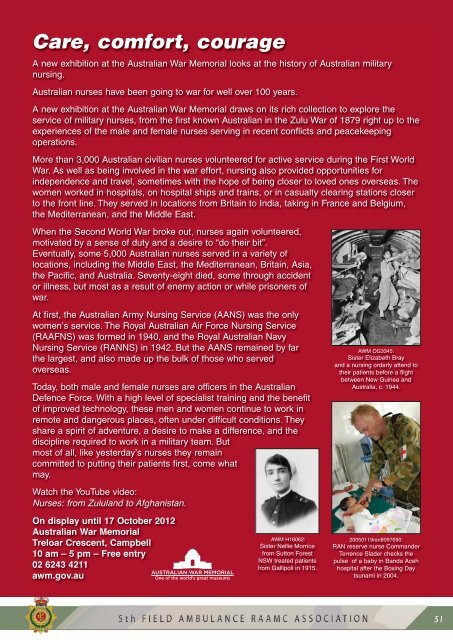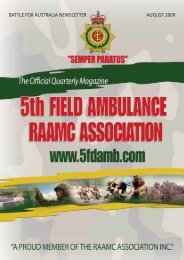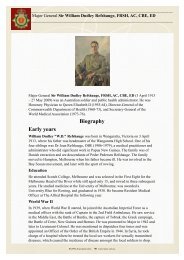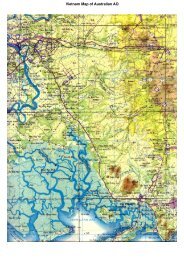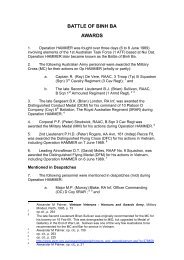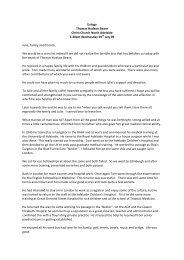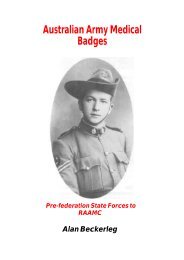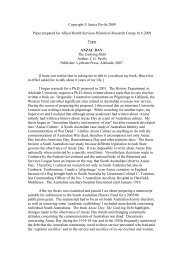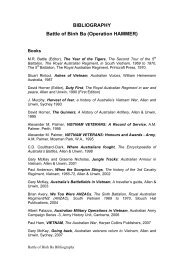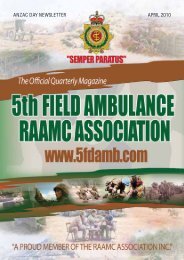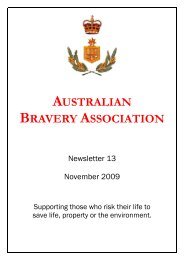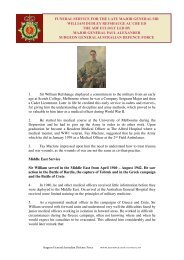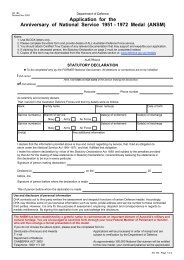December - RAAMC Assn. Home Page
December - RAAMC Assn. Home Page
December - RAAMC Assn. Home Page
Create successful ePaper yourself
Turn your PDF publications into a flip-book with our unique Google optimized e-Paper software.
Care, comfort, courage<br />
A new exhibition at the Australian War Memorial looks at the history of Australian military<br />
nursing.<br />
Australian nurses have been going to war for well over 100 years.<br />
A new exhibition at the Australian War Memorial draws on its rich collection to explore the<br />
service of military nurses, from the first known Australian in the Zulu War of 1879 right up to the<br />
experiences of the male and female nurses serving in recent conflicts and peacekeeping<br />
operations.<br />
More than 3,000 Australian civilian nurses volunteered for active service during the First World<br />
War. As well as being involved in the war effort, nursing also provided opportunities for<br />
independence and travel, sometimes with the hope of being closer to loved ones overseas. The<br />
women worked in hospitals, on hospital ships and trains, or in casualty clearing stations closer<br />
to the front line. They served in locations from Britain to India, taking in France and Belgium,<br />
the Mediterranean, and the Middle East.<br />
When the Second World War broke out, nurses again volunteered,<br />
motivated by a sense of duty and a desire to “do their bit”.<br />
Eventually, some 5,000 Australian nurses served in a variety of<br />
locations, including the Middle East, the Mediterranean, Britain, Asia,<br />
the Pacific, and Australia. Seventy-eight died, some through accident<br />
or illness, but most as a result of enemy action or while prisoners of<br />
war.<br />
At first, the Australian Army Nursing Service (AANS) was the only<br />
women’s service. The Royal Australian Air Force Nursing Service<br />
(RAAFNS) was formed in 1940, and the Royal Australian Navy<br />
Nursing Service (RANNS) in 1942. But the AANS remained by far<br />
the largest, and also made up the bulk of those who served<br />
overseas.<br />
Today, both male and female nurses are officers in the Australian<br />
Defence Force. With a high level of specialist training and the benefit<br />
of improved technology, these men and women continue to work in<br />
remote and dangerous places, often under difficult conditions. They<br />
share a spirit of adventure, a desire to make a difference, and the<br />
discipline required to work in a military team. But<br />
most of all, like yesterday’s nurses they remain<br />
committed to putting their patients first, come what<br />
may.<br />
Watch the YouTube video:<br />
Nurses: from Zululand to Afghanistan.<br />
On display until 17 October 2012<br />
Australian War Memorial<br />
Treloar Crescent, Campbell<br />
10 am – 5 pm – Free entry<br />
02 6243 4211<br />
awm.gov.au<br />
AWM H16062:<br />
Sister Nellie Morrice<br />
from Sutton Forest<br />
NSW treated patients<br />
from Gallipoli in 1915.<br />
AWM OG3345:<br />
Sister Elizabeth Bray<br />
and a nursing orderly attend to<br />
their patients before a flight<br />
between New Guinea and<br />
Australia, c. 1944.<br />
20050119ran8097690:<br />
RAN reserve nurse Commander<br />
Terrence Slader checks the<br />
pulse of a baby in Banda Aceh<br />
hospital after the Boxing Day<br />
tsunami in 2004.<br />
51


